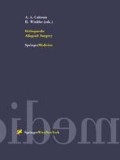Abstract
It is postulated that restoring the normal congruency between femur and tibia with normal menisci could be a solution to many mechanical knee problems.
Good functional results have been achieved with the transplantation of menisci in compartmental meniscal degeneration. However, this type of chondroprotection can only be evaluated after 10 to 20 years of follow-up.
Satisfactory incorporation of meniscal transplants has been obtained with fresh allografts, but availability remains a problem with this method of meniscal substitution.
Incorporation and ingrowth of fibroblasts have been shown in freeze-dried and deep-frozen meniscal allografts. In a small number of transplants shrinking has been observed on repeat arthroscopy.
Viable meniscal allograft implantation has been initiated in a series of 25 patients. The value of this method has been studied. With the use of a semisynthetic medium the semilunar cartilages can be kept viable without apparent loss of fibrochondroblast cell activity. During this incubation period the appropriate recipient can be selected and prepared. There is sufficient time to conduct laboratory screening and to evaluate the culture results and disease transmission factors. In this way, live transplant hazards can be avoided which results in a higher success rate.
It should be kept in mind that the knee is a weightbearing joint. The patient himself is responsible for mechanical loading, and medical control of these conditions is not always possible.
The intensity of loading thus remains an aspect that cannot always be determined scientifically and must be considered in pathology.
In view of the promising results obtained with tendon allografts and with meniscal allografts in sheep [5], meniscus transplantation in humans has become an attractive treatment option, while the outcome of synthetic meniscus replacement has been rather disappointing. Meniscal transplantation involves the necessity to store and preserve meniscal material.
Access this chapter
Tax calculation will be finalised at checkout
Purchases are for personal use only
Preview
Unable to display preview. Download preview PDF.
References
Arnauw G, Verdonk R, Harth A, Moerman J, Vorlat P, Bataillie F, Claessens H (1991) Prosthetic versus tendon allograft replacement of ACL-deficient knees. Acta Orthop Belg 57 (Suppl II): 67 – 74
Insall JN, Dorr LD, Scott RD, Scott WN (1989) Rationale of the Knee Society clinical rating system. Clin Orthop 248: 13 – 14
Verbruggen G (1990) Reparatieprocessen en katabole fenomenen in humaan articulair kraakbeen. Proefschrift tot het verkrijgen van de graad van geaggregeerde voor het hoger onderwijs, Gent.
Verbruggen G, Veys EM, Malfait AM, Cochez P, Schatteman L, Wieme N, Heynen G, Broddelez C (1989) Proteoglycan metabolism in tissue cultured human articular cartilage. Influence of piroxicam. J Rheumatol 16: 355 – 362
Wirth CJ, Milachowski KA, Weismeier K (1986) Die Meniskustransplantation im Tierexperiment und erste klinische Ergebnisse. Z Orthop 124: 508 – 512
Zukor DJ, Cameron JC, Brooks PJ, Oakeshott RD, Farine I, Rudan JF, Gross AE (1990) The fate of human meniscal allografts. In: Ewing JW (ed) Articular cartilage and knee joint function: basic science and arthroscopy. New York: Raven Press, pp 147 – 152
Zukor DJ, Cameron JC, Brooks PJ, Oakeshott RD, Gross AE (1988) The fate of human meniscal allografts. Orthop Trans 12: 658
Author information
Authors and Affiliations
Editor information
Editors and Affiliations
Rights and permissions
Copyright information
© 1996 Springer-Verlag/Wien
About this chapter
Cite this chapter
Verdonk, R. et al. (1996). Viable Meniscal Transplantation. In: Czitrom, A.A., Winkler, H. (eds) Orthopaedic Allograft Surgery. Springer, Vienna. https://doi.org/10.1007/978-3-7091-6885-1_30
Download citation
DOI: https://doi.org/10.1007/978-3-7091-6885-1_30
Publisher Name: Springer, Vienna
Print ISBN: 978-3-7091-7423-4
Online ISBN: 978-3-7091-6885-1
eBook Packages: Springer Book Archive

